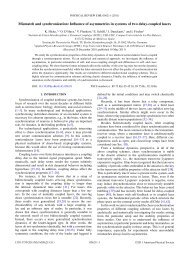CHAPTER 5. BRANES 70heuristic argument to make this claim somewhat more acceptable is that open stringscan in fact be regarded as being excitati<strong>on</strong>s <str<strong>on</strong>g>of</str<strong>on</strong>g> a D-brane world volume. <str<strong>on</strong>g>Open</str<strong>on</strong>g> stringshave <strong>on</strong>ly half the supersymmetries closed strings have, implying that also D-<strong>branes</strong>preserve <strong>on</strong>ly half <str<strong>on</strong>g>of</str<strong>on</strong>g> them. An important c<strong>on</strong>sequence <str<strong>on</strong>g>of</str<strong>on</strong>g> this is that D-<strong>branes</strong> exert n<str<strong>on</strong>g>of</str<strong>on</strong>g>orce <strong>on</strong> each other. They can exchange (closed) strings, and they attract each othergravitati<strong>on</strong>ally, but the net result <str<strong>on</strong>g>of</str<strong>on</strong>g> these interacti<strong>on</strong>s is zero. Often, <strong>on</strong>e says that anobject satisfying this c<strong>on</strong>diti<strong>on</strong> is a (half-)BPS state, where BPS stand for the namesBogomolny, Prasad and Sommerfield.5.1.3 T-duality in Type IIA and Type IIB theoriesWithout going into details, if we c<strong>on</strong>sider for example the <strong>compact</strong>ificati<strong>on</strong> <str<strong>on</strong>g>of</str<strong>on</strong>g> the X 9directi<strong>on</strong> in the Type II superstring theories, followed by carrying out T-duality in thisdirecti<strong>on</strong>, we will still obtain thatBy virtue <str<strong>on</strong>g>of</str<strong>on</strong>g> world sheet supersymmetry, alsoX 9 R −→ −X 9 R ; X 9 L −→ X 9 L. (5.34)ψ 9 R −→ −ψ 9 R ; ψ 9 L −→ ψ 9 L. (5.35)In other words, we reverse the chirality <str<strong>on</strong>g>of</str<strong>on</strong>g> the Ram<strong>on</strong>d sector right-movers, because wealter the sign <str<strong>on</strong>g>of</str<strong>on</strong>g> the d 9 0 operator. As was pointed out earlier, this operator is related tothe Dirac Γ-matrices by the relati<strong>on</strong> Γ µ = √ 2d µ 0 . Given that the chirality operator Γ11is defined asΓ 11 = Γ 0 Γ 1 . . .Γ 9 , (5.36)reversing the sign <str<strong>on</strong>g>of</str<strong>on</strong>g> <strong>on</strong>e <str<strong>on</strong>g>of</str<strong>on</strong>g> these matrices effectively inverses the chirality. As such,T-duality maps the Type IIA theory into the Type IIB theory, and vice versa. If weT-dualize another dimensi<strong>on</strong>, we will again reverse chiralities, and come back to thetheory we started out with, and so forth.5.1.4 Dirac-Born-Infeld Acti<strong>on</strong>To describe the dynamics <str<strong>on</strong>g>of</str<strong>on</strong>g> our D-<strong>branes</strong>, we still need to c<strong>on</strong>coct an acti<strong>on</strong> for them.A popular low-energy acti<strong>on</strong> is the so-called Dirac-Born-Infeld (<str<strong>on</strong>g>DBI</str<strong>on</strong>g>) acti<strong>on</strong>. We willnot derive this acti<strong>on</strong> in full detail, but merely sketch the derivati<strong>on</strong>. Details can befound in e.g. [12] §4.2, and [13] §8.5.1.Before we devise this acti<strong>on</strong>, we can already start by guessing what different c<strong>on</strong>tributi<strong>on</strong>swe need by comparing to the case <str<strong>on</strong>g>of</str<strong>on</strong>g> a string. So the first thing we would need,is a term that describes the embedding <str<strong>on</strong>g>of</str<strong>on</strong>g> the brane in the external space-time. Sec<strong>on</strong>d,we will need to c<strong>on</strong>sider c<strong>on</strong>tributi<strong>on</strong>s from coupling to the B µν field (since D-<strong>branes</strong>live in the same space-time as closed strings, and hence also feel the fields generated bythese last <strong>on</strong>es), as well as the acti<strong>on</strong> for the Maxwell field A µ generated by the openstrings ending <strong>on</strong>, and itself living <strong>on</strong> the D-brane.
CHAPTER 5. BRANES 71The embedding <str<strong>on</strong>g>of</str<strong>on</strong>g> the Dp-brane in space-time can be achieved, just as for the string,by first defining a set <str<strong>on</strong>g>of</str<strong>on</strong>g> coordinates σ n with n ∈ {0, . . .,p} <strong>on</strong> the brane. This allowsus to write the pullback <str<strong>on</strong>g>of</str<strong>on</strong>g> the space-time metric g µν to the brane, and write down thefirst part <str<strong>on</strong>g>of</str<strong>on</strong>g> our acti<strong>on</strong> asS p = −T p∫d p+1 σe −Φ √− det g µν (X)∂ α X µ ∂ β X ν , (5.37)where as usual ∂ α,β denotes derivati<strong>on</strong> with respect to σ α,β . We need to include a factore −Φ ∼ gs−1 in this acti<strong>on</strong> because this is in fact an open string tree level acti<strong>on</strong>.Moving <strong>on</strong> to the B µν an A µ fields, recall that the Kalb-Ram<strong>on</strong>d coupling <str<strong>on</strong>g>of</str<strong>on</strong>g> a stringwas given by Eq. 4.16 which we repeat for c<strong>on</strong>venience,S B = − 1 ∫2πls2 d 2 σǫ αβ B µν (X)∂ α X µ ∂ β X ν , (5.38)and use that the coupling <str<strong>on</strong>g>of</str<strong>on</strong>g> A µ to the world sheet boundary ∂M is given by∫S A = dτA µ ∂ t X µ . (5.39)∂MIf we want to mimick this behaviour for the D-brane, we are not free to take anycombinati<strong>on</strong> as we please. Space-time gauge invariance imposes a choice <strong>on</strong> us. Thepoint is that S A is invariant under a space-time gauge transformati<strong>on</strong> A µ −→ A µ +∂ µ f,but when applying a space-time gauge transformati<strong>on</strong> B µν −→ B µν + ∂ µ Λ ν − ∂ ν Λ µ wepick up a boundary termδS B = − 1 ∫2πls2 dτΛ µ ∂ τ x µ . (5.40)∂MTo cancel this boundary term and restore gauge invariane, we see that A µ should transformsimultaneously according toA µ −→ A µ − 12πls2 Λ µ . (5.41)From this we can c<strong>on</strong>clude that the <strong>on</strong>ly way to inlucde both fields in our acti<strong>on</strong> is byusing the combinati<strong>on</strong>B µν + 2πα ′ F µν (5.42)which remains invariant under both symmetries.By c<strong>on</strong>sidering the case <str<strong>on</strong>g>of</str<strong>on</strong>g> a D2-brane in Minkowski space-time, extended in directi<strong>on</strong>sX 1 and X 2 (i.e. ( σ 0 , σ 1 , σ 2) = ( t, X 1 , X 2) ) <str<strong>on</strong>g>of</str<strong>on</strong>g> which <strong>on</strong>e dimensi<strong>on</strong> is <strong>compact</strong>ified,say X 2 , <strong>on</strong>e can show that up<strong>on</strong> T-dualizing the <strong>compact</strong>ified dimensi<strong>on</strong>, the remainingD1-brane is tilted with respect to the X 1 directi<strong>on</strong>, namely the dualized directi<strong>on</strong> X ′2satisfiesX ′2 = 2πα ′ X 1 F 12 , (5.43)
















